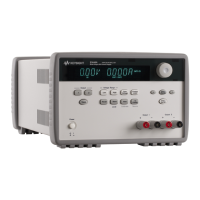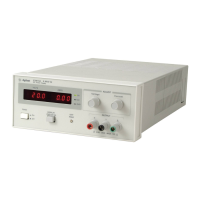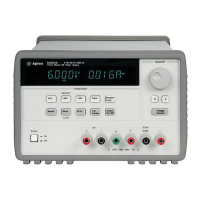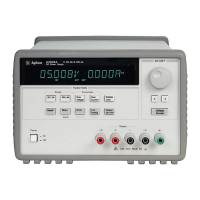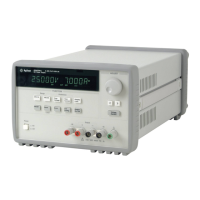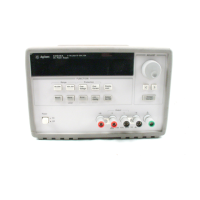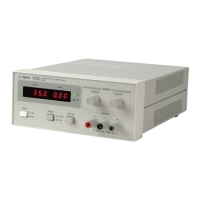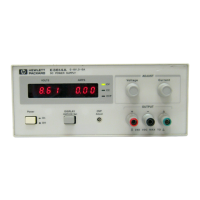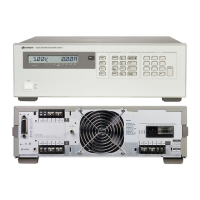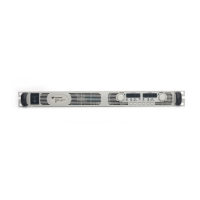Do you have a question about the Agilent Technologies E3640A and is the answer not in the manual?
Steps to verify the power supply is ready for use, including checking items and performing a self-test.
Procedures to check basic voltage and current outputs, ensuring rated outputs and proper front-panel response.
Troubleshooting steps for issues encountered when turning on the instrument, checking power and fuse.
Instructions for converting the power supply's line voltage setting and replacing the power-line fuse.
Guide on how to adjust the carrying handle for different viewing positions or portability.
Instructions and considerations for mounting the power supply in a standard 19-inch rack cabinet.
Important safety information and requirements, including Class I instrument and EMC compliance.
Lists available options like rack mount kits and accessories such as GPIB/RS-232 cables.
Overview of the power supply's features, operational capabilities, and front-panel functions.
Procedures for initial inspection, cooling, location, and cleaning of the power supply.
Details on connecting loads to the output terminals, current ratings, and voltage drops.
General description of front-panel keys and how they are used to operate the power supply.
Step-by-step guide to set up and operate the power supply in constant voltage (CV) mode.
Step-by-step guide to set up and operate the power supply in constant current (CC) mode.
Instructions for configuring GPIB or RS-232 interfaces for remote operation.
Steps to set the OVP trip level, enable the circuit, check operation, and clear conditions.
Overview of calibration features, security codes, and procedures for unsecuring the supply.
Summary of SCPI commands available for programming the power supply over the remote interface.
Basic techniques for programming the power supply using the remote interface, including APPLy and low-level commands.
Details on low-level commands for setting and controlling output voltage and current parameters.
Commands related to power supply calibration, including count, security, and data entry.
Explanation of SCPI status registers (Event, Enable, Status Byte) used for instrument conditions.
Basic introduction to the SCPI language, its structure, and command format.
List and explanation of error codes related to command syntax, parameter issues, and execution failures.
Identifies specific error codes indicating failures during the power supply's self-test procedures.
Lists error codes that may occur during calibration and adjustment of the power supply.
Provides a C/C++ code example for controlling the power supply via VISA and SCPI commands.
Demonstrates using Excel Macros (VBA) to control the power supply for data acquisition.
Explains the basic design model and operation principles of linear regulated power supplies.
Details on ideal and actual output characteristics, including CV/CC modes and noise sources.
Information on methods to extend output voltage and current beyond rated specifications.
Discussion on how remote programming affects output voltage change speed and waveforms.
Detailed performance specifications warranted within a specific temperature range and load condition.
Descriptions of performance characteristics that are not warranted but provide additional data.
A checklist of items to verify before returning the power supply for service or repair.
A checklist of common failures and basic troubleshooting steps for diagnosing power supply issues.
Explains the power-on and complete self-test procedures and associated error codes.
Lists recommended instruments for performance verification and adjustment procedures.
Information on calibration services, intervals, and procedures for unsecuring the power supply.
Steps to verify the power supply is ready for use, including checking items and performing a self-test.
Procedures to check basic voltage and current outputs, ensuring rated outputs and proper front-panel response.
Troubleshooting steps for issues encountered when turning on the instrument, checking power and fuse.
Instructions for converting the power supply's line voltage setting and replacing the power-line fuse.
Guide on how to adjust the carrying handle for different viewing positions or portability.
Instructions and considerations for mounting the power supply in a standard 19-inch rack cabinet.
Important safety information and requirements, including Class I instrument and EMC compliance.
Lists available options like rack mount kits and accessories such as GPIB/RS-232 cables.
Overview of the power supply's features, operational capabilities, and front-panel functions.
Procedures for initial inspection, cooling, location, and cleaning of the power supply.
Details on connecting loads to the output terminals, current ratings, and voltage drops.
General description of front-panel keys and how they are used to operate the power supply.
Step-by-step guide to set up and operate the power supply in constant voltage (CV) mode.
Step-by-step guide to set up and operate the power supply in constant current (CC) mode.
Instructions for configuring GPIB or RS-232 interfaces for remote operation.
Steps to set the OVP trip level, enable the circuit, check operation, and clear conditions.
Overview of calibration features, security codes, and procedures for unsecuring the supply.
Summary of SCPI commands available for programming the power supply over the remote interface.
Basic techniques for programming the power supply using the remote interface, including APPLy and low-level commands.
Details on low-level commands for setting and controlling output voltage and current parameters.
Commands related to power supply calibration, including count, security, and data entry.
Explanation of SCPI status registers (Event, Enable, Status Byte) used for instrument conditions.
Basic introduction to the SCPI language, its structure, and command format.
List and explanation of error codes related to command syntax, parameter issues, and execution failures.
Identifies specific error codes indicating failures during the power supply's self-test procedures.
Lists error codes that may occur during calibration and adjustment of the power supply.
Provides a C/C++ code example for controlling the power supply via VISA and SCPI commands.
Demonstrates using Excel Macros (VBA) to control the power supply for data acquisition.
Explains the basic design model and operation principles of linear regulated power supplies.
Details on ideal and actual output characteristics, including CV/CC modes and noise sources.
Information on methods to extend output voltage and current beyond rated specifications.
Discussion on how remote programming affects output voltage change speed and waveforms.
Detailed performance specifications warranted within a specific temperature range and load condition.
Descriptions of performance characteristics that are not warranted but provide additional data.
A checklist of items to verify before returning the power supply for service or repair.
A checklist of common failures and basic troubleshooting steps for diagnosing power supply issues.
Explains the power-on and complete self-test procedures and associated error codes.
Lists recommended instruments for performance verification and adjustment procedures.
Information on calibration services, intervals, and procedures for unsecuring the power supply.
| Load Regulation | 0.01% + 2 mV |
|---|---|
| Operating Temperature Range | 0 to 50 °C |
| Storage Temperature Range | -40 to 70 °C |
| Line Regulation | 0.01% + 2 mV |
| Ripple & Noise (Vp-p) | 2 mV |
| Display | LED |
| Programming Accuracy (Voltage) | 0.05% + 10 mV |
| Programming Accuracy (Current) | ±0.2% + 5mA |
| Readback Accuracy (Voltage) | 0.5% + 10 mV |
| Readback Accuracy (Current) | 0.5% + 5 mA |
| Ripple and Noise (20Hz to 20MHz) | 2 mV |
| Output Voltage Range | 0 to 20 V |
